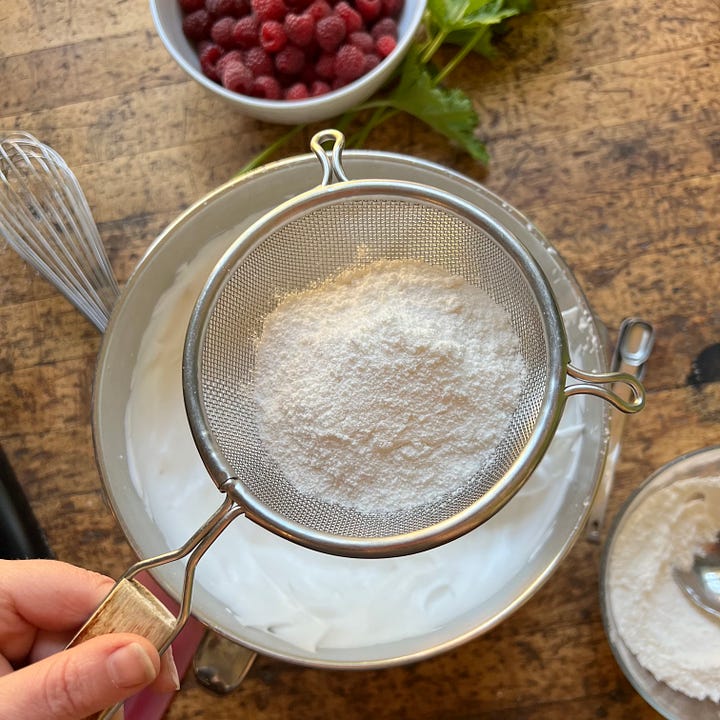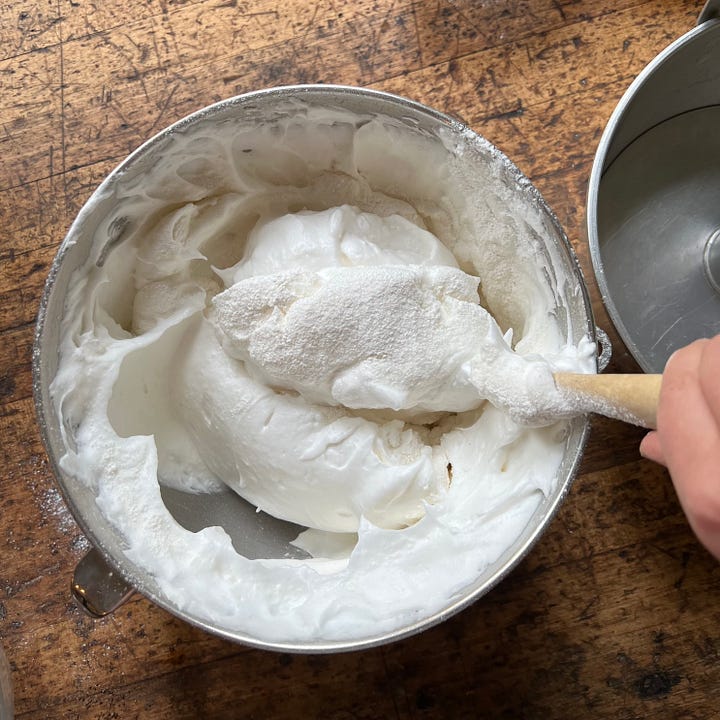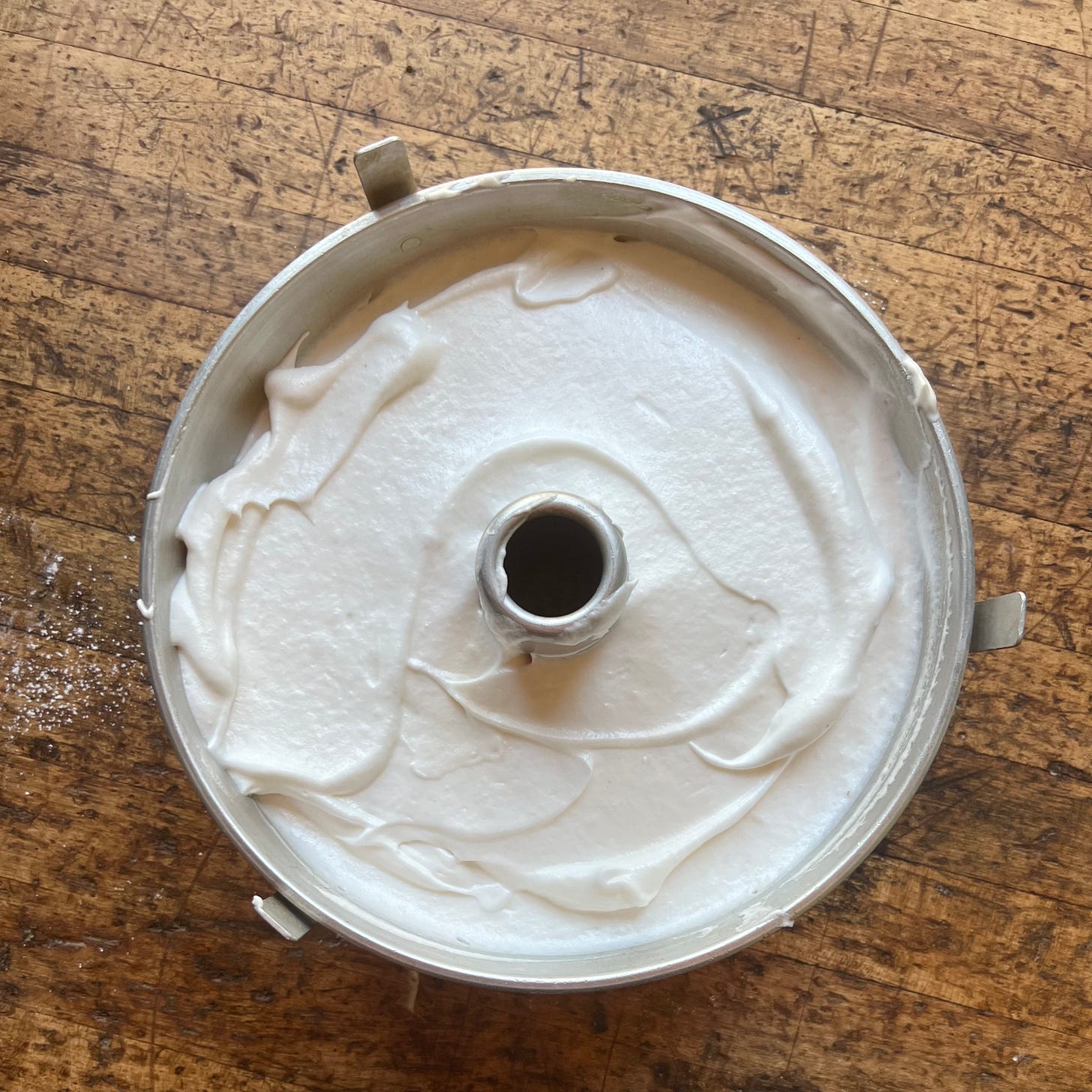Angel Food Cake is good clean fun. It no longer enjoys the “healthy” status conferred upon it during the low-fat-obsessed nineties, but it still deserves a place in your summer cake repertoire. I like to correct the fat deficit by covering it in softly whipped cream and I suggest that you do the same.
Yield: One 9-10” cake, baked in a 2-piece Angel Food Cake/Tube Pan
Ingredients
85 grams (1 cup sifted) bleached cake flour
300 grams (1 ½ cups granulated sugar), divided in two equal portions
½ teaspoon kosher salt
355 grams egg whites (1 ½ cups; from about 10-11 large eggs), at room temperature
1 teaspoon cream of tartar
1 teaspoon vanilla extract
1 tablespoon lemon juice
½ teaspoon almond extract (optional)
Make sure your cake pan is clean & dry. Do not grease. Preheat oven to 325° F.
In a medium bowl, whisk together the sifted cake flour, half of the sugar, and the salt. In a stand mixer fitted with the whisk attachment, or with a handheld electric mixer, beat the egg whites until they start to get foamy. Add the cream of tartar and continue to beat the whites on medium until they reach very soft peaks. (If you’d like a detailed and somewhat pedantic discussion of meringue, see A Meringue Digression.)
With the mixer still running, add the remaining sugar in slow stream; it should take about a minute to add all the sugar. Continue to beat the meringue on medium-high speed until it has reached medium peak. Add the vanilla, lemon juice and almond extract and beat until just combined.
Take the bowl off the mixer and remove the whisk. Sift one third of the flour and sugar mixture over the top of the meringue. Fold in the flour with a rubber spatula until almost completely combined. Repeat two more times with the remaining thirds of flour. Fold until the flour is completely incorporated, but do not mix further or the batter will start to deflate.
Transfer batter to the pan and smooth the top. Gently tap the pan on a hard surface to release any air bubbles or gaps. Bake until the cake is nicely browned and the top springs back when pressed, about 45-50 minutes.
Invert the cake immediately onto a flat surface; a sheet pan or a wooden cutting board works well. (Tube pans often have tabs that will keep the cake pan aloft and allow airflow underneath the cake when flipped over. If your pan doesn’t have these flaps, consider inverting the center of the pan onto the neck of a sturdy bottle.) Let the cake cool completely upside down, about 2 hours. To un-mold, flip the cake pan back over, run a knife around the edges of the pan and invert onto a plate. Remove the released part of the pan, then run a sharp knife along the flat bottom of the pan/top of the cake to release completely. Angel food cake keeps for several days, wrapped, and at room temperature. But I like it best on the day it’s made. Serve with cream & perhaps some Macerated Raspberries.


Notes on this recipe
Usually, I banish almond extract from my baking, but I like to use a small amount here because it anchors the cake in the vintage realm without overpowering it with “almond” flavor. If you can’t stand almond extract, feel free to leave it out.
Regrettably, this is one recipe that requires a specific pan. The good news is that I’ve never gone to Goodwill without seeing at least one Angel Food Cake Pan/Tube Pan on the shelves. You want to make sure to avoid any pans that have a nonstick stick coating; one of the important ways that Angel Food Cake rises and stays risen is by “climbing” the sides of the pan. A nonstick pan (or accidentally greasing the pan) will cause the cake to slump and fall because it can’t stick to the sides. Basically: if you see a pan that’s cheap & aluminum, that’s the pan for you!
This cake requires bleached cake flour. I know that we, as a society, have moved away from bleached flour – and for most applications, that’s the right move. But not here. Buy that box of Softasilk and stash it away for the next time you’re making this, or another delightfully light cake.





